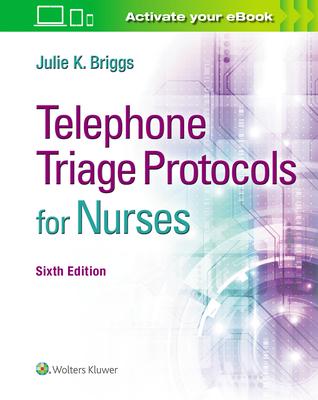- NEW and updated protocols offer current best practices and reflect changes in access to medications and health care
- Protocols address adult, pediatric, geriatric, maternal/child, home health concerns, current health issues, and communicable disease outbreaks
- NEW protocols include arthritis, chronic obstructive pulmonary disease (COPD), elder abuse, stroke symptoms, and Zika virus
- Post-operative conditions and considerations have been added to numerous protocols
- Expanded appendices include altered mental status, PTSD, suicide prevention, and emergency preparedness
- Alpha-organized protocols help you quickly locate topics by symptom or condition
- Table of contents by body system helps you quickly locate topics by body system, body part or set of related symptoms
- Peer-reviewed by nursing experts
- Easy-to-follow question-asking flow chart - Yes or No answers lead to specific care recommendations
- Ideal guidance for all nurses, particularly those in triage and ambulatory practice
- Sorts life-threatening problems from those not requiring physician or emergency care
- Increases consistency of advice and documentation
- Nurse Alerts - help the nurse identify potentially life-threatening conditions related to the symptoms and provides additional information to consider when choosing a protocol or triaging the caller's concern
- Symptoms alpha-organized and grouped by level of urgency, addressing injuries, trauma, pain, swelling and other symptoms for:
- Body part problems
- Body system problems
- Chronic and infectious diseases
- Behavioral problems
- Pediatric-specific problems
- Maternal/obstetric specific problems or conditions
- Sections under every symptom or condition include:
- Key Questions to ask caller
- Other Protocols to Consider
- Reminder - what to note for proper documentation
- Assessment - Yes or No questions to determine the urgency of symptoms or conditions
- Actions - clear direction following Yes or No answers to questions
- Immediate actions - proven protocols that refer caller to emergency, physician, or at-home care instructions
- Home Care Instructions - comprehensive actions to take before emergency care, before appointment, or at-home care
- Emergency Instructions - in-the-moment first aid
- Report the Following Problems - what caller should tell their personal or ER physician
- Seek Emergency Care Immediately - if certain symptoms occur
- Reminder to determine if caller agrees with the advice provided and if not, reevaluate
- Must-have resource for medical offices, clinics, schools, community referrals, emergency departments, urgent care centers, home health agencies and managed healthcare providers

- NEW and updated protocols offer current best practices and reflect changes in access to medications and health care
- Protocols address adult, pediatric, geriatric, maternal/child, home health concerns, current health issues, and communicable disease outbreaks
- NEW protocols include arthritis, chronic obstructive pulmonary disease (COPD), elder abuse, stroke symptoms, and Zika virus
- Post-operative conditions and considerations have been added to numerous protocols
- Expanded appendices include altered mental status, PTSD, suicide prevention, and emergency preparedness
- Alpha-organized protocols help you quickly locate topics by symptom or condition
- Table of contents by body system helps you quickly locate topics by body system, body part or set of related symptoms
- Peer-reviewed by nursing experts
- Easy-to-follow question-asking flow chart - Yes or No answers lead to specific care recommendations
- Ideal guidance for all nurses, particularly those in triage and ambulatory practice
- Sorts life-threatening problems from those not requiring physician or emergency care
- Increases consistency of advice and documentation
- Nurse Alerts - help the nurse identify potentially life-threatening conditions related to the symptoms and provides additional information to consider when choosing a protocol or triaging the caller's concern
- Symptoms alpha-organized and grouped by level of urgency, addressing injuries, trauma, pain, swelling and other symptoms for:
- Body part problems
- Body system problems
- Chronic and infectious diseases
- Behavioral problems
- Pediatric-specific problems
- Maternal/obstetric specific problems or conditions
- Sections under every symptom or condition include:
- Key Questions to ask caller
- Other Protocols to Consider
- Reminder - what to note for proper documentation
- Assessment - Yes or No questions to determine the urgency of symptoms or conditions
- Actions - clear direction following Yes or No answers to questions
- Immediate actions - proven protocols that refer caller to emergency, physician, or at-home care instructions
- Home Care Instructions - comprehensive actions to take before emergency care, before appointment, or at-home care
- Emergency Instructions - in-the-moment first aid
- Report the Following Problems - what caller should tell their personal or ER physician
- Seek Emergency Care Immediately - if certain symptoms occur
- Reminder to determine if caller agrees with the advice provided and if not, reevaluate
- Must-have resource for medical offices, clinics, schools, community referrals, emergency departments, urgent care centers, home health agencies and managed healthcare providers
Spiral
$103.32